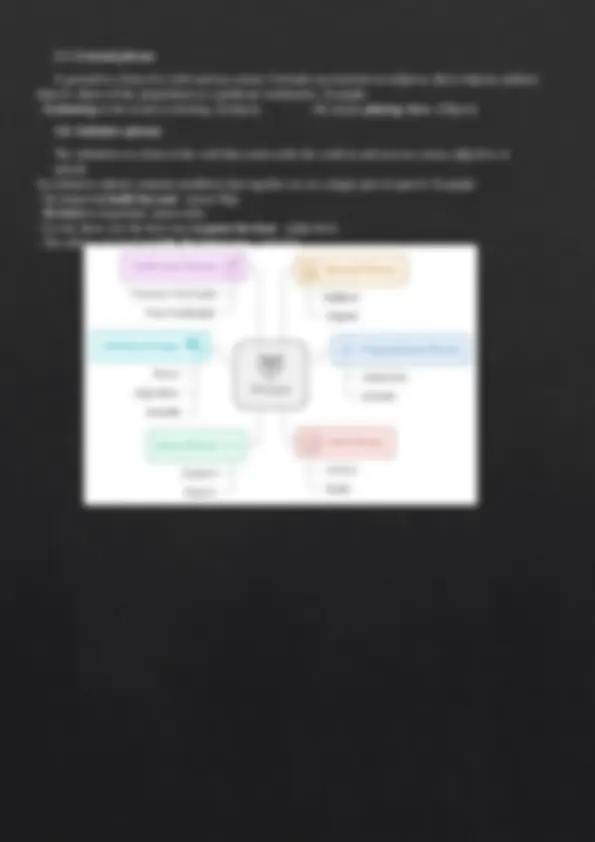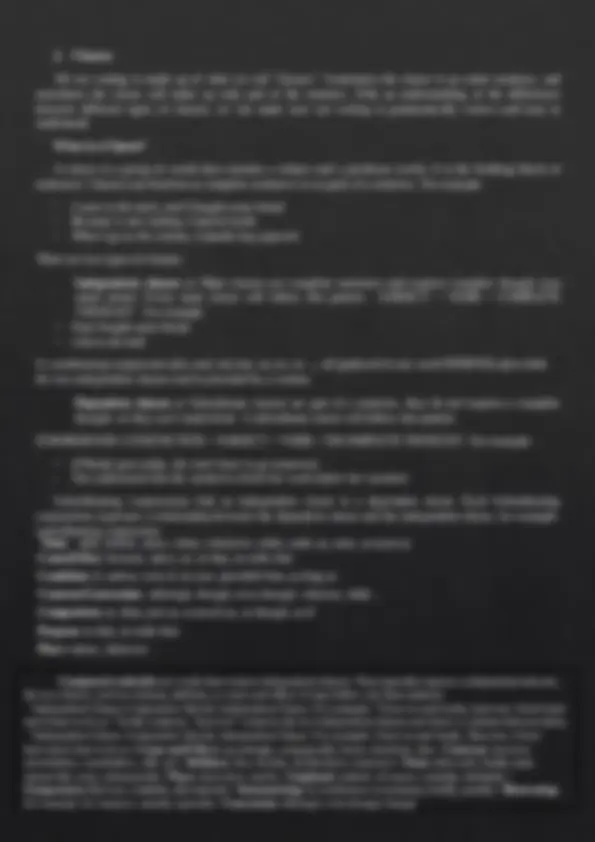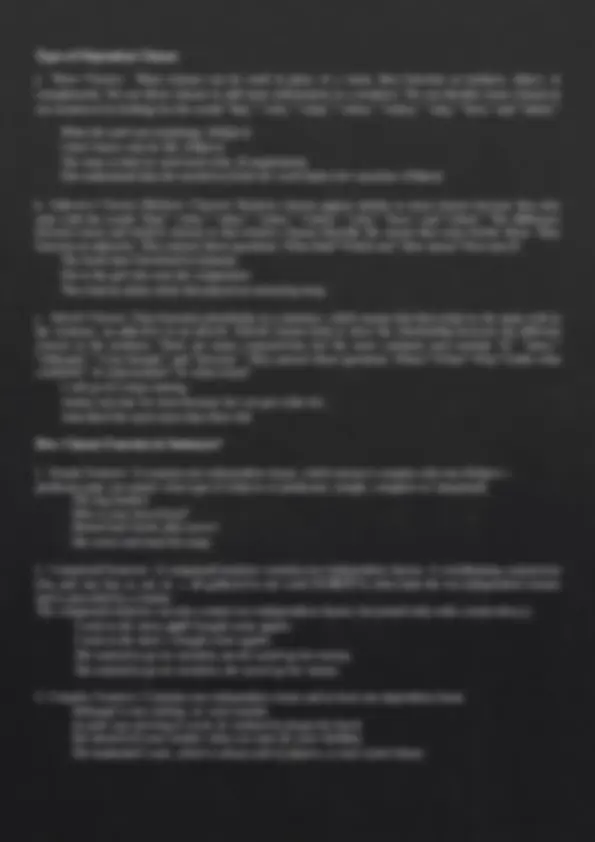





Study with the several resources on Docsity

Earn points by helping other students or get them with a premium plan


Prepare for your exams
Study with the several resources on Docsity

Earn points to download
Earn points by helping other students or get them with a premium plan
Community
Ask the community for help and clear up your study doubts
Discover the best universities in your country according to Docsity users
Free resources
Download our free guides on studying techniques, anxiety management strategies, and thesis advice from Docsity tutors
This lecture provides a detailed explanation of sentence structure, focusing on the fundamental elements of clauses and phrases. It explores the different types of phrases, including noun phrases, verb phrases, prepositional phrases, and gerund phrases, and their functions within sentences. The lecture also delves into the distinction between independent and dependent clauses, highlighting their roles in creating simple, compound, complex, and compound-complex sentences. This comprehensive guide is ideal for students seeking to improve their understanding of grammar and enhance their writing skills.
Typology: Study Guides, Projects, Research
1 / 6

This page cannot be seen from the preview
Don't miss anything!




Sentence
Clause (Independent)
(Contains a subject and a predicate)
Predicate
Verb Phrase
Subject
Noun Phrase
Determiner + Noun + Prepositional Phrase
Verb Noun Phrase Adverbial
"The" "student" "with the red hair" "answered" Determiner + Noun "correctly"
"the question"
1. Phrases:
In a sentence, words do not only act individually, but also in groups. The grouped words act together as a
unit which may function as a modifier, a subject, a verb, an object, or a predicate nominative. The most
common group of related words is known as the phrase. Phrases are groups of related words that do not
contain both a subject and a verb. They act as parts of speech within sentences. In other words, phrases are
groups of words that serve as nouns, adjectives or adverbs in sentences. Because sentences are made up of
phrases and clauses, understanding these basic elements of sentence structure will help you to create writing
that is clear, concise, stylistically interesting and free of errors such as sentence fragments.
What is a phrase?
A phrase is two or more words that do not contain the subject-verb pair necessary to form a clause.
Phrases can be very short or quite long. Here are two examples:
a. After lunch
b.After slithering down the stairs and across the road to scare nearly to death Mrs. Philpot
busy pruning her rose bushes
Traditionally “phrase” is defined as “a group of words that does not contain a verb and its subject and
is used as a single part of speech.”.
Level : 1st year Bachelor Module : Grammar Student : Mr. HANNACHI
Functions of Phrases
Phrases can serve different purposes in a sentence:
Subject : Swimming is fun. (Gerund phrase as the subject).
Object : He loves reading books. (Gerund phrase as the object).
Complement : Her goal is to win. (Infinitive phrase as the complement).
Adverbial : She spoke with confidence. (Prepositional phrase as adverbial).
Adjectival : The boy with the blue hat is my friend. (Prepositional phrase as adjective).
Types of Phrases and their Functions
Certain phrases have specific names based on the type of word that begins or governs the word
group: noun phrase, verb phrase, prepositional phrase, infinitive phrase, participle phrase, and gerund phrase.
1.1. Prepositional phrase:
A prepositional phrase is a group of words that begins with a preposition and ends with a noun or
pronoun. This noun or pronoun is called the “Object of the preposition “.
Preposition + noun, pronoun, gerund.
Preposition + modifier + noun, pronoun, gerund.
Eg: by the wall in the desert. The
prepositional phrase acts as an adjective or
adverb (adjunct), as an
adjective, the prepositional phrase will answer the question Which one? As an adverb, a prepositional phrase
will answer questions such as How? When? or Where? example:
The book on the table is mine. → which book is mine? (Adjective: modifies book ).
She ran through the park. → how did she ran? (Adverb: modifies ran ).
Amber finally found the umbrella wedged under the front seat → Where did Amber locate the
umbrella? Under the front seat!
1.2. Noun phrase:
A noun phrase includes a noun, a person, place, or thing, and the modifier(s) (either before and/or after)
that distinguish it. Optional modifier + noun + Optional modifier.
For example: A great English teacher →Teacher = noun; a, great, English = modifiers.
It acts as a subject, object, or complement. Examples :
The tall boy is my friend. (Subject).
I saw a beautiful painting. (Object).
teacher. Prep phrase acts as adj noun phrase as SC
1.3. Verb phrase:
Sometimes a sentence can communicate its meaning with a one-word verb. Other times, however, a
sentence will use a verb phrase, a multi-word verb, to express more nuanced action or condition. It acts as an
action or a state, example: She is reading a book. They might have left.
1.4. Participial phrase:
A participle phrase will begin with a present or past participle. It acts as an adjective to modify a noun,
example: The child crying loudly needs help. (Present participle). Exhausted from the trip , she rested.
Annoyed , the customer stalked out of the store. (Past participle).
NB: While both present participles and gerunds end in - ing, they function differently in a sentence.
Present Participle: Acts as a verb or adjective, used to form progressive tenses (e.g., "I am running.") or can be used as an
adjective to modify a noun (e.g., "The running water was refreshing.")
Gerund: Acts as a noun. It can be the subject, object, or complement of a sentence (e.g., "Running is good exercise.") or (e.g.,
"I enjoy swimming.")
2. Clauses:
All our writing is made up of what we call “clauses.” Sometimes the clause is an entire sentence, and
sometimes the clause will make up only part of the sentence. With an understanding of the differences
between different types of clauses, we can make sure our writing is grammatically correct and easy to
understand.
What is a Clause?
A clause is a group of words that contains a subject and a predicate (verb). It is the building block of
sentences. Clauses can function as complete sentences or as parts of a sentence. For example:
I went to the store, and I bought some bread.
Because it was raining, I stayed inside.
When I go to the cinema, I usually buy popcorn.
There are two types of clauses:
Independent clauses or Main clauses are complete sentences and express complete thought (can
stand alone). Every main clause will follow this pattern: SUBJECT + VERB = COMPLETE
THOUGHT. For example:
Paul bought some bread.
I threw the ball.
A coordinating conjunction (for, and, nor, but, or, yet, so → all gathered in one word FANBOYS) often links
the two independent clauses and is preceded by a comma.
Dependent clauses or Subordinate clauses are part of a sentence, they do not express a complete
thought, so they can’t stand alone. A subordinate clause will follow this pattern:
SUBORDINATE CONJUNCTION + SUBJECT + VERB = INCOMPLETE THOUGHT. For example:
If Wendy goes today, she won’t have to go tomorrow.
Subordinating conjunctions link an independent clause to a dependent clause. Each Subordinating
conjunction expresses a relationship between the dependent clause and the independent clause, for example:
subordinating conjunction
Time after, before, since, when, whenever, while, until, as, once, as soon as
Cause/Effect because, since, as, so that, in order that
Condition if, unless, even if, in case, provided that, as long as
Contrast/Concession although, though, even though, whereas, while…
Comparison as, than, just as, as much as, as though, as if
Purpose so that, in order that
Place where, wherever
Conjunctive adverbs are words that connect independent clauses. They typically express a relationship between
the two clauses, such as contrast, addition, or cause and effect. It may follow one these patterns:
Independent Clause; Conjunctive Adverb, Independent Clause. For example: "I love to read books; however, I don't have
much time to do so." In this sentence, "however" connects the two independent clauses and shows a contrast between them.
Independent Clause. Conjunctive Adverb, Independent Clause. For example: I love to read books. However, I don't
have much time to do so. Cause and Effect: accordingly, consequently, hence, therefore, thus / Contrast: however,
nevertheless, nonetheless, still, yet / Addition: also, besides, furthermore, moreover / Time: afterward, finally, later,
meanwhile, next, subsequently / Place: elsewhere, nearby / Emphasis: indeed, of course, certainly, definitely /
Comparison: likewise, similarly, alternatively / Summarizing: in conclusion, in summary, briefly, quickly / Illustrating:
for example, for instance, namely, typically / Concession: although, even though, though
Types of Dependent Clauses
a. Noun Clauses: Noun clauses can be used in place of a noun, they function as (subject, object, or
complement). We use these clauses to add more information to a sentence. We can identify noun clauses in
our sentences by looking for the words “that,” “who,” “what,” “when,” “where,” “why,” “how,” and “which.”
What she said was surprising_._ (Subject)
I don’t know why he left. (Object)
The issue is that we need more time. (Complement)
She understood that she needed to finish her work before her vacation. (Object)
b. Adjective Clauses (Relative Clauses): Relative clauses appear similar to noun clauses because they also
start with the words “that,” “who,” “what,” “when,” “where,” “why,” “how,” and “which.” The difference
between noun and relative clauses is that relative clauses describe the nouns that come before them. They
function as adjective. They answer these questions: What kind? Which one? How many? How much?
The book that I borrowed is fantastic_._
She is the girl who won the competition.
They had an alarm clock that played an annoying song.
c. Adverb Clauses: They function adverbially in a sentence, which means that they relate to the main verb in
the sentence, an adjective or an adverb. Adverb clauses help to show the relationship between the different
clauses in the sentence. There are many conjunctions, but the more common ones include “if,” “since,”
“although,” “even though,” and “because.” They answer these questions: Where? When? Why? Under what
condition? In what manner? To what extent?
I will go if it stops raining.
Amina was late for class because her car got a flat tire.
John liked the meal more than Kate did.
How Clauses Function in Sentences?
predicate) pair. (no matter what type of subjects or predicates; simple, complete or compound)
The dog barked.
Who is your best friend?
Ahmed and Amine play soccer.
She wrote and read the essay.
(for, and, nor, but, or, yet, so → all gathered in one word FANBOYS) often links the two independent clauses
and is preceded by a comma.
The compound sentence can also contain two independent clauses, but joined only with a semicolon (;)
I went to the store , and I bought some apples.
I went to the store; I bought some apples.
She wanted to go on vacation , so she saved up her money.
She wanted to go on vacation ; she saved up her money.
Although it was raining, we went outside.
As john was arriving to work, he realized he forgot his lunch.
You should tell your mother what you want for your birthday.
The basketball court, which is always full of players, is near Lynn’s house.